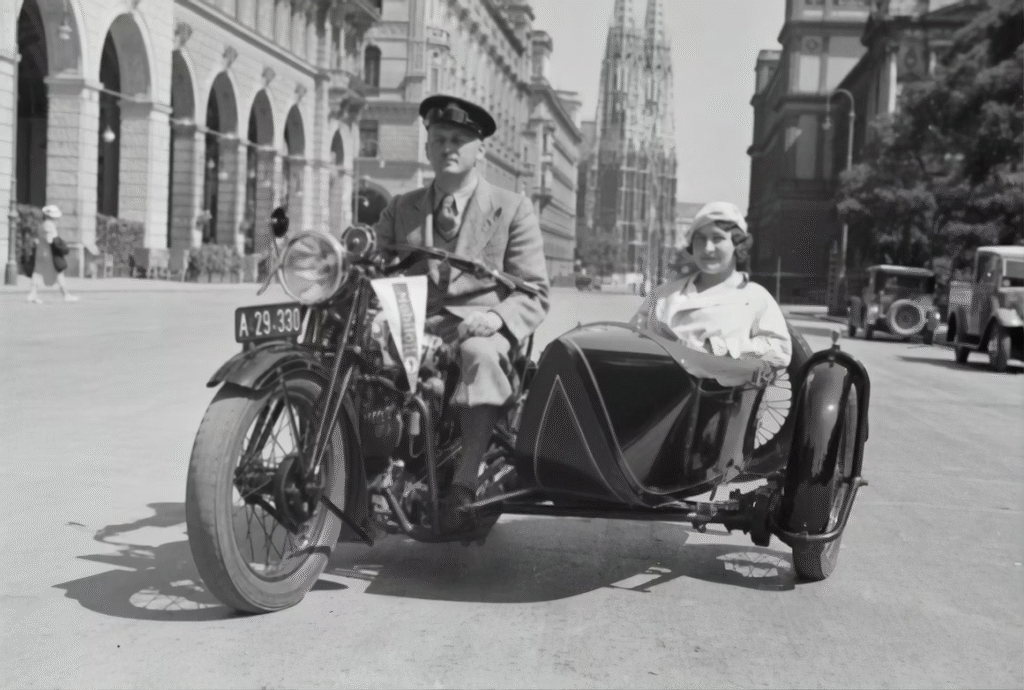The 1920s look at a glance
Shorter suit jackets, rising lapels, and a move to wider trousers by mid‑decade created a clean, athletic line that distinguished 1920s menswear from earlier, longer coat styles reserved for formal occasions.
By 1925, Oxford bags—dramatically wide trousers—became a headline trend, while sweaters, knickerbockers, and casual separates brought sportswear into daily life for the first time at scale.
Suits and tailoring
Early‑decade jackets sat higher on the waist with narrower lapels, echoing wartime influence, before widening later and pairing with looser sleeves for comfort and movement by the second half of the 1920s.
Trousers started relatively narrow and short—with visible socks—then transitioned to cuffed hems and increasingly generous cuts as fashion relaxed and silhouettes broadened.
Double‑breasted vests worn under single‑breasted jackets emerged late in the decade, adding depth and formality to otherwise simplified lines.
Oxford bags explained
Oxford bags were extremely wide‑leg trousers popularized by Oxford undergraduates, spreading quickly beyond campus and across the Atlantic as a defining menswear statement of the mid‑to‑late 1920s.
Leg openings commonly expanded from roughly 22–23 inches in early versions to widths approaching or exceeding 40 inches as the look exaggerated for drama and dance‑floor mobility.
Contemporary references note flannel construction and pairings with short jackets or knitwear, placing Oxford bags firmly in the era’s comfort‑forward, youthful wardrobe.
Plus fours and casual sport style
Plus fours—knee pants extending four inches below the knee—offered more freedom of movement than traditional knickers and became a signature for golfers and leisure pursuits after 1924.
Variations like plus twos and plus sixes existed, but plus fours led adoption and were boosted in visibility by the style influence of the Prince of Wales across Britain and the United States.
Guides to the decade also highlight sweaters, plus fours, and other roomy trousers as core casualwear, confirming the broader shift from rigid tailoring to expressive, sport‑led looks.
Knitwear, leisure, and the new weekend uniform
V‑neck pullovers, cardigans, and shawl‑collar sweaters surged in popularity as the 1920s normalized leisure dressing alongside suits, reinforcing the decade’s comfort revolution.
Golf, tennis, yachting, and beach culture pushed pleated trousers, knickerbockers, blazers, and swim garments into the mainstream, establishing sportswear as a permanent pillar of menswear.
Automobiles and travel further encouraged practical pieces such as driving caps and lightweight outer layers, aligning fashion with mobility and modern life.

Formal day and evening dress
For daytime ceremony, the morning suit persisted with its traditional authority, signaling continuity with prewar dress codes even as other categories modernized.
Evening standards tilted decisively toward the short tuxedo over the tailcoat, which increasingly read as old‑fashioned and class‑bound by late decade.
Fabrics, colors, and patterns
Flannel featured prominently in trousers—including Oxford bags—because it balanced drape, structure, and comfort, making it ideal for the era’s wider legs and active lifestyles.
Pattern play—checks, windowpanes, and plaids—grew across trousers and separates, supporting bolder sportswear aesthetics while classic solids remained foundational in tailoring.
The overall palette ranged from dependable grays and navies to lighter seasonal tones, with casualwear embracing more variety to signal youth and leisure.
Hats and accessories
Flat caps and soft hats complemented casual separates, while ties and vests reinforced the suit’s versatility from office hours to evening outings as lapels widened later in the decade.
Driving caps and goggles appeared in leisure contexts, especially among early adopters of motoring who embraced functional add‑ons as part of a modern lifestyle.
Build a 1920s wardrobe today
- Start with a single‑breasted suit with wider trousers and a slightly shorter jacket body to capture the era’s proportion shift without feeling like costume.
- Add a flannel trouser separate in a roomier cut or true Oxford bags for statement days, pairing with a V‑neck sweater or short jacket to keep the silhouette athletic.
- For casual or heritage looks, rotate plus fours with long socks and a soft knit, reserving formal touches like a double‑breasted waistcoat for evenings.
Event styling ideas
For a Gatsby‑style party, combine a wider‑lapel jacket, a double‑breasted vest, and cuffed trousers to balance elegance with 1920s authenticity.
For daytime leisure, choose plus fours with a lightweight sweater and soft cap for a convincing sport‑inspired ensemble that stays wearable off the course.
For dance floors, Oxford bags offer dramatic movement and period swagger—especially in flannel—while a short jacket or knit keeps the top half grounded.
Common mistakes to avoid
Avoid late‑30s and 40s references like padded shoulders and very broad, structured chests, which break the cleaner, more natural sloped shoulder line of the 1920s.
Skip ultra‑skinny trousers; the decade moved toward comfort and width, especially by mid‑ to late‑1920s when Oxford bags and cuffed hems dominated trendsetting circles.
Don’t pair tailcoats with casual daywear; use a tuxedo for evening formality to align with the period’s modern preference.
Quick FAQ
- What defined 1920s fashion male in tailoring?
Higher‑set, shorter jackets early on, widening lapels later, and a move from narrow to wider, cuffed trousers by the mid‑decade. - What’s the difference between Oxford bags and plus fours?
Oxford bags are full‑length, very wide‑leg trousers, while plus fours are knee‑length trousers extending four inches below the knee for sport and leisure. - Did the tuxedo replace the tailcoat?
Yes—by late decade, the short tuxedo was preferred for evening, with the tailcoat viewed as dated and overly formal.
Visit Here: 80s Hip Hop Fashion: 10 Celebrated, Definitive Styles